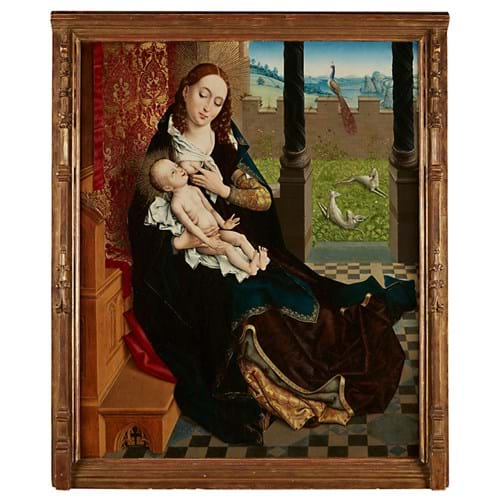
On February 27, the small oil on cradled oak panel - one of only a dozen pictures by a workshop known only by the moniker Master of the Embroidered Foliage – was hammered down to a phone bidder for a multi-estimate $2,050,000 (£1.58m) plus buyer’s premium.
The name of the artist (or perhaps a group of artists active in late 15th century Brussels) was coined in 1926 by German art historian Max Jakob Friedländer (1867-1958), who likened the way the foliage was painted to the repeated pattern of stitches in embroidery.
Minor alterations
Most known paintings depict the Virgin and Child in similar poses and – although minor alterations appear to the landscapes in the background – follow earlier works by the Brussels artist Rogier van der Weyden (1399-1464). Examining this picture under infrared light revealed changes were made to the background: originally, two standing figures were underdrawn in the area where a peacock, symbol of immortality, now stands.
The last link in a long provenance chain painting beginning with The Spanish Gallery, London, 1912 is the New York University. It was given to the university by ambassador Ruth Farkas. The condition of the work (now housed in a 19th century gothic revival frame) was very good with only small areas of retouching to the sky.
There was speculation before the sale that it would make much than its $150,000-250,000 guide. In 2012 Christie’s Amsterdam sold Adam and Eve in the Garden of Eden by the Master of the Embroidered Foliage for a premium-inclusive €1,420,200 (£1.14m) - the previous auction record for the artist.
Saleroom to move
Shortly before the sale Freeman’s announced it is moving from its longstanding home to new premises. The firm, the subject of a management buyout in 2016, has been at 1808 Chestnut Street since the 1924.
Company chairman Alasdair Nichol said the plan is now to operate from two sites: a “new city centre space with features that will enhance both the in-room and online auction experiences” and a second facility “that will serve as the exchange for more moderately priced items.” The Chestnut Street premises will now be sold.





